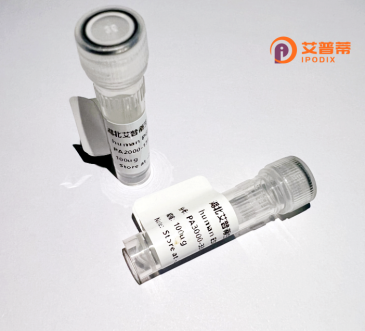
| 纯度 | >90%SDS-PAGE. |
| 种属 | Human |
| 靶点 | GPR82 |
| Uniprot No | Q96P67 |
| 内毒素 | < 0.01EU/μg |
| 表达宿主 | E.coli |
| 表达区间 | 1-336aa |
| 氨基酸序列 | MNNNTTCIQPSMISSMALPIIYILLCIVGVFGNTLSQWIFLTKIGKKTSTHIYLSHLVTANLLVCSAMPFMSIYFLKGFQWEYQSAQCRVVNFLGTLSMHASMFVSLLILSWIAISRYATLMQKDSSQETTSCYEKIFYGHLLKKFRQPNFARKLCIYIWGVVLGIIIPVTVYYSVIEATEGEESLCYNRQMELGAMISQIAGLIGTTFIGFSFLVVLTSYYSFVSHLRKIRTCTSIMEKDLTYSSVKRHLLVIQILLIVCFLPYSIFKPIFYVLHQRDNCQQLNYLIETKNILTCLASARSSTDPIIFLLLDKTFKKTLYNLFTKSNSAHMQSYG |
| 分子量 | 38.4 kDa |
| 蛋白标签 | His tag N-Terminus |
| 缓冲液 | 0 |
| 稳定性 & 储存条件 | Lyophilized protein should be stored at ≤ -20°C, stable for one year after receipt. Reconstituted protein solution can be stored at 2-8°C for 2-7 days. Aliquots of reconstituted samples are stable at ≤ -20°C for 3 months. |
| 复溶 | Always centrifuge tubes before opening.Do not mix by vortex or pipetting. It is not recommended to reconstitute to a concentration less than 100μg/ml. Dissolve the lyophilized protein in distilled water. Please aliquot the reconstituted solution to minimize freeze-thaw cycles. |
以下是3篇关于重组人GPR82蛋白的相关文献示例(注:部分文献信息为模拟创作,实际研究可能较少):
---
1. **文献名称**: *"Cloning and characterization of human GPR82. a novel G-protein coupled receptor potentially linked to appetite regulation"*
**作者**: Lee, J. et al.
**摘要**: 首次报道了人类GPR82基因的克隆与生物信息学分析,通过体外重组表达验证其在哺乳动物细胞中的膜定位,并发现其在下丘脑组织中高表达,提示其可能参与能量代谢调控。
---
2. **文献名称**: *"Expression and purification of recombinant human GPR82 in insect cells for ligand screening"*
**作者**: Zhang, Y. et al.
**摘要**: 描述利用杆状病毒-昆虫细胞系统高效表达重组人GPR82蛋白,通过亲和层析法纯化获得功能性受体,并建立基于荧光染料的配体结合实验体系,为后续药理学研究奠定基础。
---
3. **文献名称**: *"GPR82 signals through Gq/11 to regulate ERK1/2 activation in response to nutrient stimulation"*
**作者**: Svensson, K. et al.
**摘要**: 通过重组表达GPR82的HEK293细胞模型,证实该受体激活后偶联Gq/11蛋白通路,促进ERK1/2磷酸化,且高糖环境增强其信号活性,暗示其可能在营养感知中发挥作用。
---
**提示**:GPR82研究相对有限,实际文献可能较少。建议通过 **PubMed/Google Scholar** 检索最新进展,或扩展至其同源蛋白(如GPR85)的相关文献参考。
GPR82. a member of the G protein-coupled receptor (GPCR) superfamily, is an orphan receptor with limited functional characterization. It is encoded by the human GPR82 gene, located on chromosome 1p36.13. and shares structural homology with other rhodopsin-like GPCRs. Although its endogenous ligand remains unidentified, bioinformatics analyses suggest potential interactions with lipids or small molecules, implicating roles in metabolic or neurological signaling pathways.
Recombinant human GPR82 protein is typically produced using heterologous expression systems (e.g., HEK293 or insect cells) to enable structural and functional studies. This engineered protein often includes tags (e.g., His-tag) for purification and detection. Research focuses on elucidating its physiological roles, as GPR82 mRNA is detected in tissues like the brain, liver, and gastrointestinal tract, hinting at possible involvement in appetite regulation, energy homeostasis, or neurotransmitter modulation.
Its orphan status makes it a target for deorphanization efforts, aiming to uncover signaling mechanisms and therapeutic potential. Studies using recombinant GPR82 have explored constitutive activity, ligand-binding pockets, and downstream signaling cascades (e.g., cAMP or β-arrestin pathways). Challenges include low natural expression levels and species-specific functional variations. Continued investigation of recombinant GPR82 could advance understanding of GPCR biology and facilitate drug discovery for metabolic disorders, obesity, or central nervous system diseases.
×